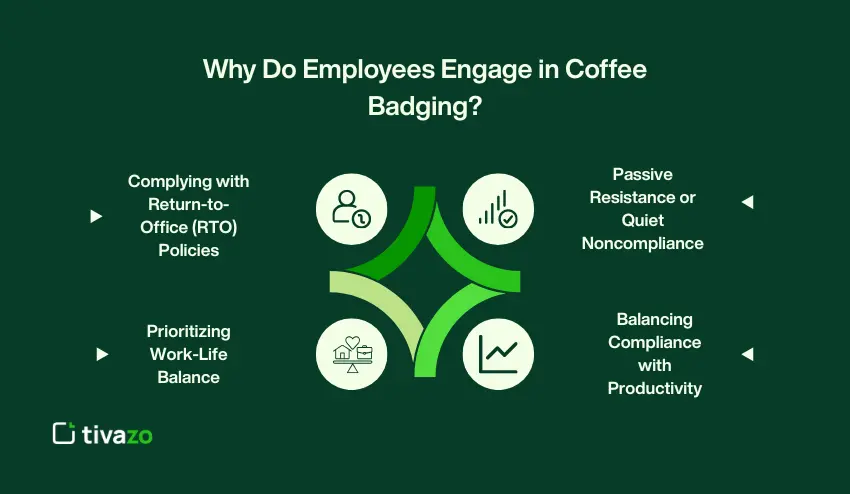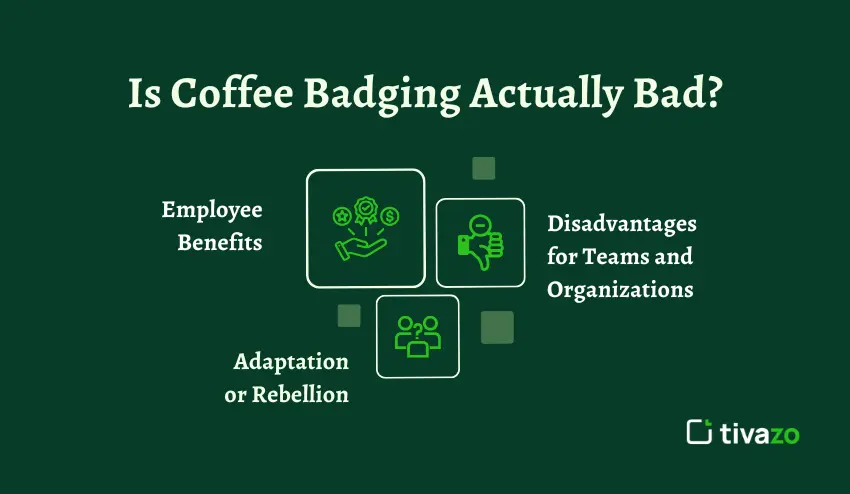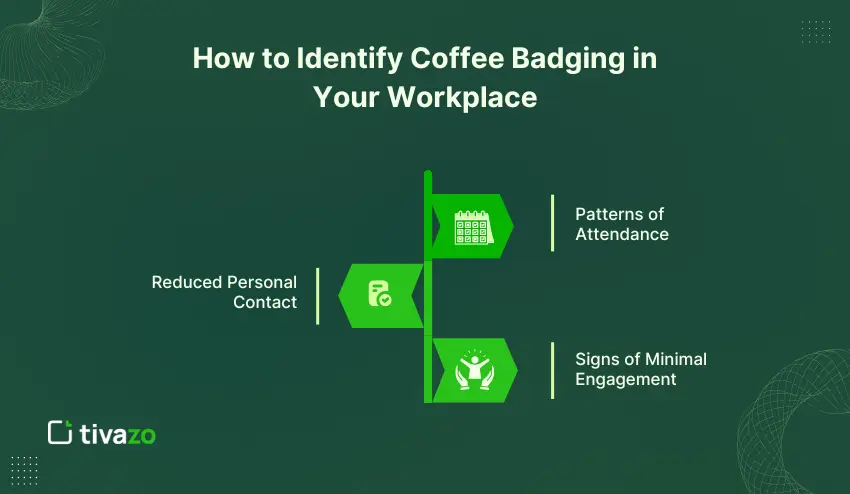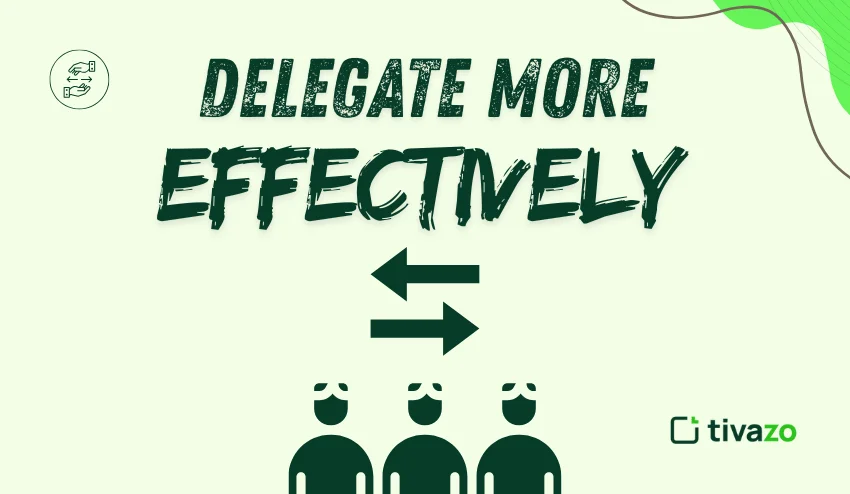It is 9:15 a.m., an employee badges in, makes small talk with a coworker over coffee, and then leaves the office just minutes later to complete their work remotely. Coffee badging or fake office attendance is quickly becoming one of the most discussed topics in modern workplaces, representing the ongoing tensions between office attendance obligations and the underlying flexibility workers have taken advantage of since hybrid work became a popular option.
What began as an innocuous, passive-aggressive method of resisting “return-to-office” (RTO) requirements has developed into a cultural phenomenon. Coffee badging, among other trends, represents how employees have begun to redefine productivity and presence for future workplaces. Worker presence at work is not equivalent to completing work. For many people, this is not about shirked responsibilities; this is about reprioritizing flexible work, autonomy, and mental clarity in a rapidly inflexible work environment.
This article will break down what coffee badging is, why it is occurring, what it means for employees, and what it will mean for organizations. There will be explanations of why coffee badging is occurring, examples that exist in the “real world,” and suggestions for how an organization can effectively respond to this trend. Ultimately, this article will demonstrate that coffee badging means a lot more than having a cup of coffee. More importantly, it highlights the future of employment relationships, workplace culture, trust, and flexibility.
What is Coffee Badging?
Coffee badging is when employees quickly check in at the office, often swiping their security badge as a record of attendance, grab a coffee, engage in small talk for a few minutes, and then leave to work elsewhere, usually from home. It’s a symbolic act to record attendance in the office without actually spending a full workday on-site.
The phrase comes from “badging systems” within a corporate setting that track physical office entry as proof of attendance. As hybrid work models became more commonplace, employees creatively met their presence expectations without losing the flexibility gained from pandemic remote work. Coffee badging is one of the low-key alternatives to maintaining that flexibility while still “checking the presence box” by physically entering the office.
Research conducted in the workplace between 2023 and 2025 has suggested rapid movement toward coffee badging. Surveys from Owl Labs, Gallup, and Flex Index reported that nearly 58% of U.S. hybrid employees reported that they have coffee badged likely at least once. Coffee badging is not simply a West Coast phenomenon; higher refreshment consumption rates among hybrid workers have also been reported in the U.K. (43%) and Germany (37%).
Coffee badging is typically characterized in relation to other behaviors evolving in contemporary work, such as quiet quitting or presenteeism, but attendance just to badge is distinctively different. While presenteeism simply means being there to get paid, even though you are unproductive, and quiet quitting means to stay but only doing the bare minimum of work, coffee badging represents more of a presence optics showing up to comply with a company’s policy with regard to work structures while attempting to prioritize working on their own productive tasks outside or in the same workplace.
In summary, coffee badging represents a divergence in the way companies have framed work as employees experience it. While a brief office check-in may outwardly appear to be an act of defiance, it is more of a matter of blending new notions of being independent, focused, and managing time with a company’s expectations for employees.
Why Do Employees Engage in Coffee Badging?
Employees participate in brief visits to the office for several reasons. Though this behavior may be perceived as trivial, it suggests emerging workplace dynamics and attitudes toward hybrid work practices. Below, we categorize the general reasons and rationales for this behavior.

1. Complying with Return-to-Office (RTO) Policies
Hybrid work policies may specify an in-office requirement one or several day of the week, and brief office check-ins offer a way for employees to meet these written requirements without committing to a full workday in the office. Again, it’s a grey area between meeting written requirements and a flexible approach on the employee’s part.
2. Prioritizing Work-Life Balance
Remote workers, specifically, may be motivated by the potential grim scenarios of long commutes and the potential loss of work-life integration. Office visits may allow employees to reduce the bad aspects of encountering coworkers while maintaining the benefits of remote work. Brief office check-ins may allow employees to:
- Reduce commuting stress
- Preserve uninterrupted work time while remote
- Preserve mental well-being and focus.
3. Passive Resistance or Quiet Noncompliance
Some workers see the requirements of in-office full-time work as an anachronism of work; a brief “check-in” is a form of nonverbal dissent that communicates dissatisfaction but doesn’t actively challenge management.
4. Balancing Compliance with Productivity
Coffee badging is a way for employees to accommodate company policy while ensuring the work environment is optimized for productivity. Coffee badging could be described as an evolving set of workplace priorities; autonomy, flexibility, and outcomes are more important than just presence. An employee who engages in coffee badging is looking to be effective while not being unnecessarily micromanaged.
Is Coffee Badging Actually Bad? (An Objective Opinion)
Coffee Badging is a worthwhile consideration at various workplaces: is it positive, an alternative to regular time, or inhibiting productivity and culture? The answer is not simple, since there may be potential benefits and potential drawbacks.

1. Employee Benefits
Short stop-bys around the office can help employees’ well-being and performance. Employees feel a connection and sense of control in their workspace. Short visits can lower burnout, since employees are assured of not being in the office long, or needing to commute, or worried about long days. On balance, if taking care of business in the office and getting on your way home, there will be better focus and productivity at home (when distractions are not present).
2. Disadvantages for Teams and Organizations
Whilst coffee badging can be a positive for individuals, it can be wrong for organizations. Teams may not have impromptu collaboration or connection after normal hours, and managers may perceive short visits as a lack of commitment to the shared mission. In this scenario, there may be equity issues in the way particular employees stay for the full office day and carry the perceived burden for productivity. Coffee badging may exacerbate the design of hybrid work to recognize systemic issues, rather than the behavior of coffee badging itself being negative.
3. Adaptation or Rebellion
Some people believe coffee badging is a variation of adaptation, not necessarily rabble-rousing. Individuals are reacting to aligned policies and attempting to be responsive while producing. In work contexts where leadership is trust-based, there are fewer significant consequences for coffee badges, since outputs are valued over modalities of presence. Coffee badging is a shift to valuing outcomes and adaptable environments in the workplace.
How Coffee Badging Impacts Work Culture and Productivity
Coffee badging has not only implications for what an employee does individually, but we can also analyze it in relation to the idea of office culture and team-based work. Understanding the implications of coffee badging can help organizations work through other issues that may be at the heart of the behavior.
1. Effects on Office Energy and Collaboration
Brief, frequent visits to the office can lower the overall energy in the workplace. Teams are, therefore, potentially missing brainstorming and spontaneous discussions that normally take place when employees are fully in the office and present. This can impact the experience of creativity, sharing ideas, and a sense of community with coworkers.
2. Managerial Challenges
From the managerial perspective, coffee badging causes a new challenge in the evaluation of productivity. Traditional productivity metrics, such as time spent at the desk, become less useful for evaluating productivity when the only thing you can evaluate is whether the employee is present. Managers first realize they need to judge productivity, but may easily misinterpret the level of commitment in terms of productivity or effort.
3. A Symptom of Deeper Problems
Most times, coffee badging is a symptom of deeper problems, such as a lack of engagement or a poor employee experience in the office. In this situation, coffee badging conveys the disparity between the expectations of the employees versus the expectations of the employer. This highlights the need to enact more deliberate hybrid policies as well as to have a more engaging experience for employees in the office working groups.
How to Identify Coffee Badging in Your Workplace
The most crucial part of identifying this practice is understanding behavior trends; it’s not about regular monitoring of employees and where performance should be measured and perceiving whether hybrid work is being used in an established manner. Intervening early will allow managers to manage issues before they have escalated unnecessarily.

1. Patterns of Attendance
When employees log in for only a short period and are absent for major parts of the day, they may be “badging” in long enough to count as present. Again, look for the patterns of leaving early, taking very short lunch breaks, and coming in at very strict and scheduled times to be present.
2. Reduced Personal Contact
In some cases, teams will even discover fewer instances of face-to-face collaboration amongst employees. A “badged” employee may even go so far not to attend meetings in the office or limit personal time in a common area, or engage in limited incidental or brief social interactions, but are still present as per their working hours.
3. Signs of Minimal Engagement
Some other small indicators of “coffee badging” are lower levels of participation on office-wide initiatives, minimal discussion contribution, or a tendency for employees to prefer to work completely remote after being in the office briefly. These actions often indicate an employee prefers to work remotely but will “badge” or check in to be accountable.
Examining Real-World Company Responses to Short Office Check-Ins
Looking at how organizations respond to short durations in the office can provide us with a variety of responses and outcomes. Companies differ in how they respond to personnel who attend the office for short, intermittent check-ins. The responses from a variety of companies can yield insight for hybrid workplace policies.
1. Amazon: Strong Enforcement
Amazon demonstrated a strong emphasis on monitoring employees’ in-office presence. Their employees are expected to attend set schedules, and generally, short check-ins are discouraged. While this approach seeks adherence to office schedules, it can create dissatisfaction and low morale for hybrid employees.
2. Samsung: Some Flexibility with Incentives
Samsung seeks a balance between attendance and engagement through offering flexible hybrid options. Employees can choose their timing for being in the office, and they are incentivized to attend joint collaboration sessions. This option fosters meaningful collaboration while discouraging time spent in the office with not meaningfully purpose.
3. EPA: Technologically Monitored Presence
The Environmental Protection Agency (EPA) is a hybrid workplace that utilizes software tools to monitor attendance patterns while maintaining hybrid optionality. Data-driven approaches work for managing hybrid employees to monitor attendance patterns, but it does not detract from monitoring presence. The data allows managers to observe current trends by identifying patterns and determine if engaging with employees to seek improvements is warranted, without placing undue burdens on them.
What We Learned
By observing these responses, we can compare deeply, and trust-based attendance policies generally have better morale and productivity levels and strict enforcement of policies and strategies can create compliance but not necessarily satisfaction and flexible plans as long as they stress meaningful presence over hours, ultimately foster better engagement.
Expert Insights on the Coffee Badge
Experts provide perspectives on the growing trend of quick office check-ins and how that behavior reflects the trends in today’s offices. including people like Frank Weishaupt, the CEO of Owl Labs, who describe these brief visits in terms of productivity optimization rather than disengagement. It may be that the employees use these visits to check in, but are still taking time to re-frame and do deep work from home, and they are trying to strike a balance between being present in the office and productivity.
From the work psychology perspective, these behaviors reflect broader culture and psychological changes, where employee attitudes are more in favor of autonomy, trust, and flexibility, suggesting that, at times, results and output can trump physical presence. What some managers would view as not being fully committed is simply an employee change in what the employee believes is productive work.
HR professionals recognize that management styles must also take on the same shift in behaviors. Organizations that emphasize outcomes versus attendance and are also willing to engage in open communication with their employees are much more likely to develop and retain motivated and engaged employees. When organizations assume that short office visits equate to laziness or refusal to comply, it creates mistrust and declines overall morale. In contrast, when leadership exhibits encouragement and understanding of what the original intent of the behavior was, not only does the company stay engaged, but it also calibrates its hybrid policy perspective.
Security and Technology Issues
Traditional badge systems only keep track of employee entry and exit from the office and provide little insight into what actual productivity or engagement looks like. Such metrics can lead managers to get overly focused on physical presence rather than actual results.
To this end, many organizations are beginning to utilize new technologies like occupancy sensors, Wi-Fi tracking, and HR analytics dashboards. Each of these can assist in obtaining more precise data about office occupancy by better detailing the when, how, and to some extent, the where of each room’s usage while also accounting for hybrid work flexibility.
As is the case with many technology solutions, care must be taken with the implementation. It is critical for organizations to strike a balance between protecting privacy and accountability with their employee populations to avoid distrust or perceptions of over-surveillance. Therefore, when organizations do track activity, they do so in a clear and public way and explain what activity is being tracked and why.
Doing so, especially considering any ethical considerations around how data will be used, reduces the likelihood of undermining motivated work environments. When technology is optimally and appropriately used, technologies can help leaders gain an understanding of workplace patterns while working to inform office engagement, collaboration, and design.
Effective Approaches for Dealing with Coffee Badging
Organizations can manage short visits to the office by focusing on trust, engagement, and performance, not physical time in the office. Some approaches include:
- Adopt flexible work policies – Put greater emphasis on outcomes over attendance in the office, to help employees find balance with their in-office and remote work.
- Create a compelling purpose for coming into the office – Invite employees to work collaboratively, hold team-building events, or provide a learning opportunity to entice employees to solicit engagement in the office (although they could do this work virtually instead of in person).
- Keep communication channels open – Utilize employee feedback as it relates to hybrid policy and practice – How did it go? Any ideas to improve engagement?
- Evaluate performance based on performance – Be clear and agreed-upon outcomes with check-ins to understand productivity, rather than measuring based on logged hours in the office.
- Create a culture of trust – Manage accountability through performance, not surveillance, to build morale, and compliance visits to the office.
- Have a reward system for participating (collaboration) – Reward employees for in-office engagement, not punish employees who did not physically attend.
- Iterate your hybrid policy – Use data and employee feedback to progress policy changes related to in-person engagement in alignment with employee needs and organizational goals.
Conclusion
The practice of coffee badging is more than a quick visit to an office coffee machine – it signals a change in workforce culture. It does not highlight how employees are melding flexibility, autonomy, and productivity in the context of previous expectations to attend or report for work.
This trend is telling organizations that rigid policies don’t necessarily reflect workplace norms anymore. Organizations that are aiming to develop trust, engagement, and outcomes, instead of worrying about attendance, will find it easier to obtain and manage a good morale, teamwork, and subsequently better performance.
In the end, coffee badging is indicative that the definition of work is evolving, as are the measures of work. This behavior of coffee badging can create a more inviting opportunity for hybrid work models or systems that can create more meaningful in-office attendance opportunities that have clear expectations and flexibility when in the office.




